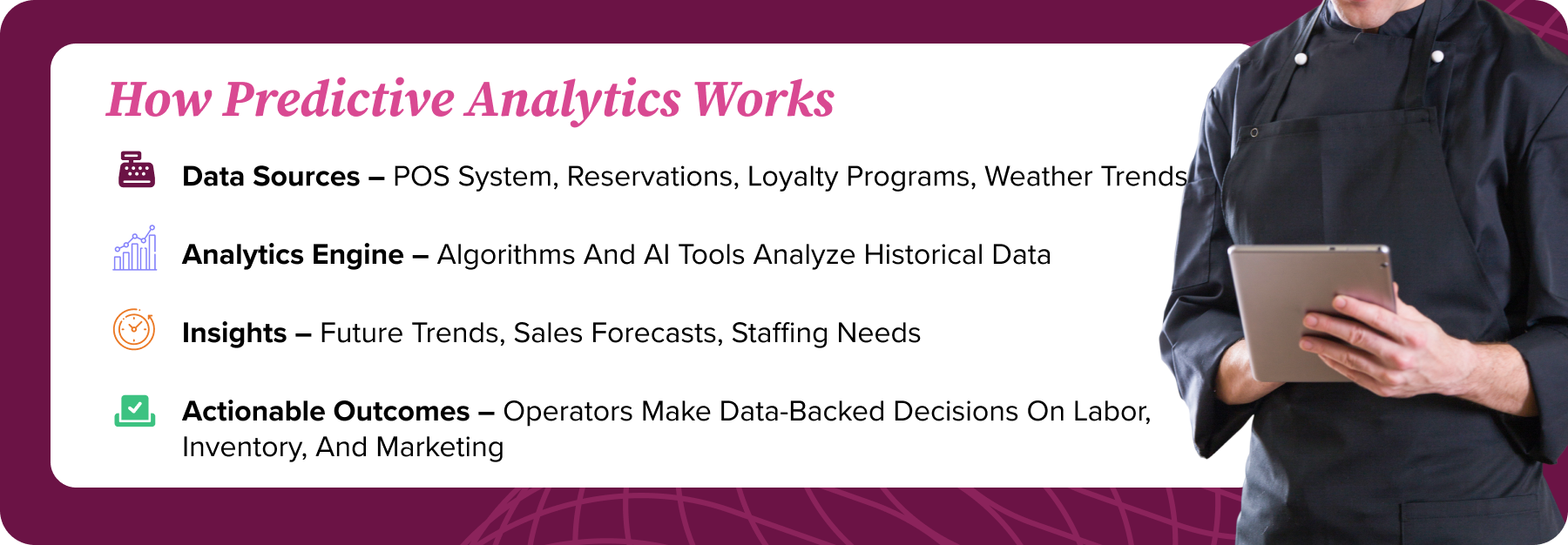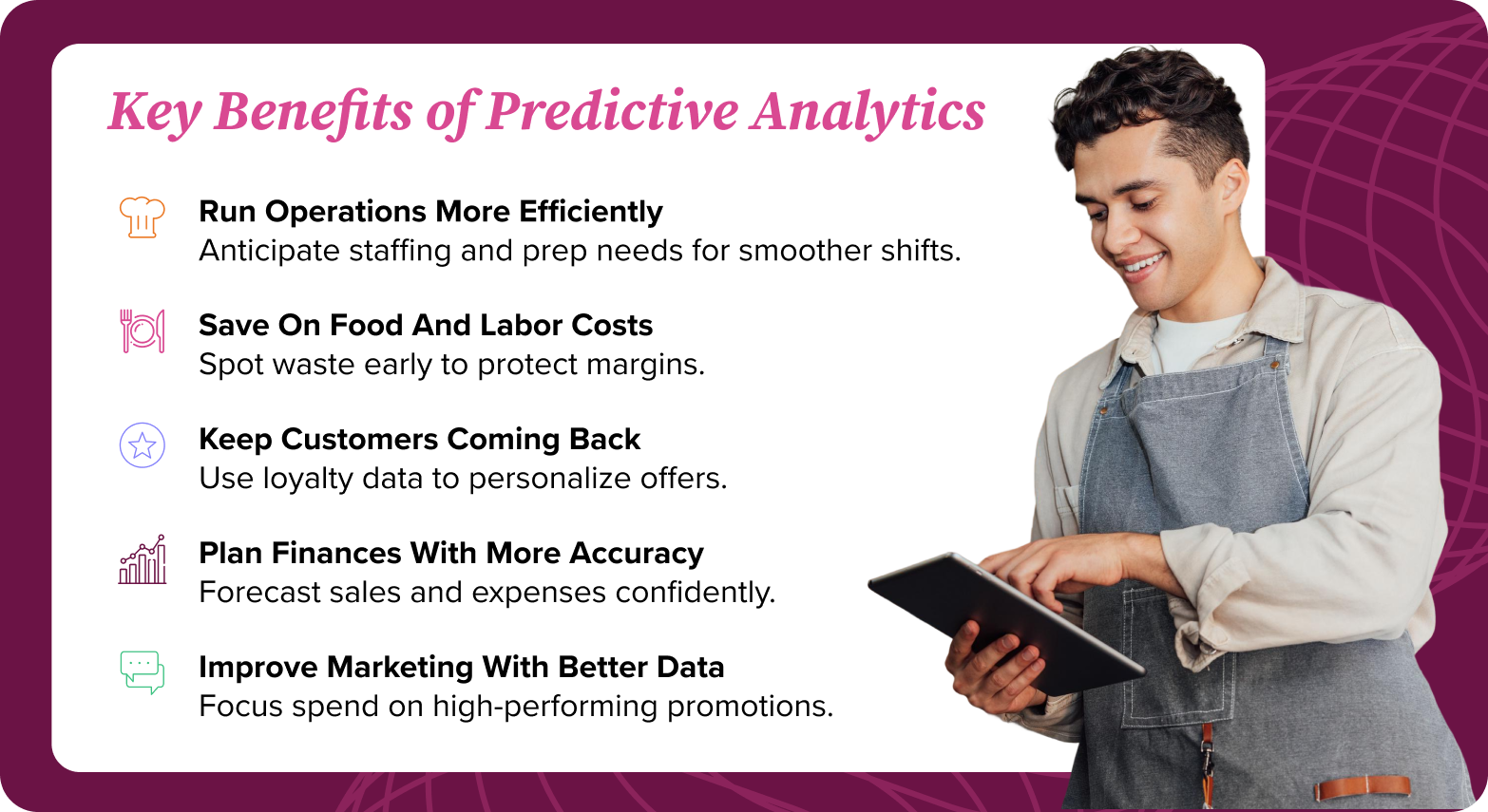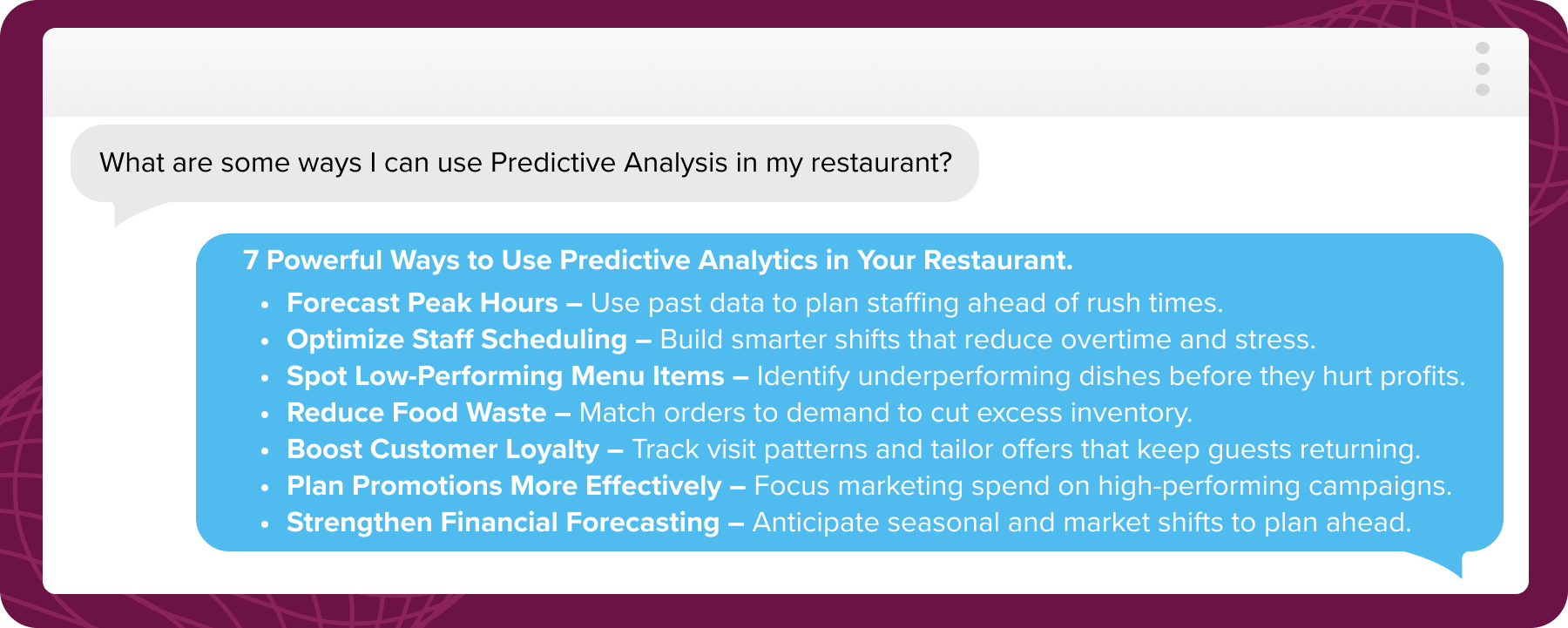Imagine having a crystal ball for your restaurant — one that shows tomorrow’s busiest shifts, next week’s top-selling menu items, and the guests who are most likely to visit. That’s essentially what restaurant predictive analytics delivers. By turning today’s data into tomorrow’s insights, it helps operators anticipate challenges and seize opportunities before they happen.
Unlike simple forecasting tools or generic data reports, predictive analytics takes a future-focused approach, helping operators anticipate peak hours, identify loyalty trends, and flag underperforming menu items before they impact profits. For directors of operations and back-office managers, it’s a smarter way to reduce costs, optimize staffing, and build stronger customer connections.
What Are Restaurant Predictive Analytics?
Restaurant predictive analytics combine historical data, advanced algorithms, and machine learning to develop robust forecasts of future sales patterns. Unlike standard reports that simply log what already happened, predictive models look ahead and anticipate expected patterns in sales, labor, and customer behavior.
In restaurants, these insights are generated by analyzing data from POS systems, reservations, loyalty programs, and even weather trends. By turning this raw data into actionable, forward-looking trends, operators are better positioned to make proactive decisions on labor needs, inventory orders, and menu changes that drive revenue and optimize operations.

Key Benefits of Predictive Analytics
Predictive analytics help operators move from guesswork and assumptions to confident, data-backed decision-making. Here’s how it can transform your restaurant’s daily operations and long-term performance:

- Run operations more efficiently: Having tools that accurately identify scheduling and prep needs will reduce stress on your team and help you focus less on putting out fires and more on creating a high-quality guest experience.
- Save on food and labor costs: Insight into where over-ordering and over-staffing occur lets you adjust before waste piles up, helping you better control expenses and protect your profit margins.
- Keep customers coming back: Spotting loyalty patterns enables you to tailor your promotions and menu offerings, building stronger connections with customers and encouraging repeat business.
- Plan finances with more accuracy: Reliable sales and expense forecasts give you more accurate budget numbers and better cash flow control, reducing surprises and supporting smarter investment decisions.
- Improve marketing with better data: Knowing which promotions resonate most with your guests helps you focus your marketing spend where it delivers the best results, eliminating wasted dollars and strengthening your ROI.
Common Challenges to Consider
Like any new approach, incorporating predictive analytics into your workflows comes with its own hurdles. Recognizing and addressing these challenges early helps operators get the most from their investment:
- Inaccurate or incomplete data: Predictive models are only as strong as the data behind them. If your data isn’t clean or consistent, your predictions won’t hold up. Establish a regular process for validating inputs and integrating systems to ensure your analytics reflect reality.
- High setup costs or tech issues: New tools can feel expensive and complicated. Starting small with one use case can help manage costs and ease the transition, or partnering with a trusted vendor can provide reliable support and efficiency from the beginning.
- Staff may not be properly trained: Even the best tools will fail if your team doesn’t know how to apply them. Invest in proper training to build your team’s trust in both the data and their ability to incorporate it in daily decision-making.
- Tracking the wrong metrics: Too much data can distract from what truly matters. Focus on a few high-impact restaurant metrics first to keep your analytics practical and actionable.
7 Powerful Ways to Use Predictive Analytics in Your Restaurant
The true value of predictive analytics lies in how it shows up day-to-day. Using these practical steps, you can turn abstract data into actionable insights that make your restaurant more agile and profitable.

1. Forecast Peak Hours
Use historical sales and reservation data to predict busy times, then adjust staffing and prep work ahead of the rush to avoid bottlenecks.
2. Optimize Staff Scheduling
Analyze labor performance by shifts or seasons, then build smarter schedules that reduce overtime, balance workloads, and maximize coverage while minimizing costs.
3. Spot Low-Performing Menu Items
Track item sales trends to identify dishes that are losing popularity, then remove or rework them before they can negatively impact your profitability.
4. Reduce Food Waste
Compare forecasts with past usage to fine-tune order quantities, then adjust purchasing to avoid over-ordering and keep inventory lean.
5. Boost Customer Loyalty
Look at repeat visit patterns to see what keeps guests coming back, then design promotions or loyalty perks to reinforce those habits.
6. Plan Promotions More Effectively
Review which deals actually drive sales, then focus your marketing spend on proven ads that will attract guests and deliver consistent ROI.
7. Strengthen Financial Forecasting
Use the predictive models to anticipate revenue swings tied to seasons, events, weather, or sales cycles, then build budgets that plan for those financial challenges before they hit.
How to Get Started With Predictive Analytics
Launching predictive analytics in your restaurant requires some preparation, but it doesn’t have to be overwhelming. By following a few clear steps, you can ease the transition and start seeing quick wins almost immediately.
Review Your Current Tools and Data
Start by assessing your POS, scheduling, and inventory systems to identify gaps where your data doesn’t line up. Metrics should be tagged consistently across systems, with safeguards in place to prevent duplication or inaccurate calculations.
Set Clear Goals
Define what you want predictive analytics to improve, such as reducing food waste, optimizing labor, or boosting loyalty. Take baseline measurements, then set specific targets and track your progress against them.
Pick the Right Software
Look for solutions that integrate with your existing systems and provide easy-to-read dashboards. If your platform can pull in data from multiple sources and deliver insights without a heavy lift, you’re positioned for a smooth rollout.
Create Reports and Automate Them
Build recurring reports on your key metrics, like labor cost percentage or weekly sales forecasts. If your team can access these easily without digging to find the right spreadsheet, they’ll be more likely to use the system consistently and correctly.
Train Your Team
Provide hands-on training that shows managers not just how the tools work, but how to apply the insights to daily decisions. If staff can explain how analytics affect their schedules, orders, and processes, you’ll see smoother operations with less hands-on oversight.
Getting Started With Back Office
You don’t need to be a data expert to use predictive analytics effectively. And you don’t need a massive overhaul to see results — just clean data, clear goals, and the right tools. Even small implementations in a few key places can create noticeable improvement in efficiency, cost savings, and guest satisfaction.
Back Office makes the transition to using predictive analytics easier by consolidating your important metrics all in one place. Whether you’re an independent operator or managing multiple locations, predictive analytics can help you shift from reacting to leading by turning everyday decisions into long-term growth.
FAQs About Restaurant Predictive Analytics
Is this only for big restaurants?
Not at all. Predictive analytics scales to any size operation. Even small restaurants can use simple insights to improve scheduling, reduce waste, and strengthen guest relationships without heavy investments.
How much data do I need?
You don’t need massive databases or multiple software packages. Start small with the data you have in your POS and scheduling systems, then expand as you gain confidence and identify value.
Does this replace human decisions?
No. Predictive analytics supports managers by providing clearer insights. You still make the final call, but strong data and done-for-you trends can help to streamline your decision-making process.
When will I see results?
Most restaurants see quick wins within two weeks in areas such as scheduling efficiency or reduced food waste. As you expand the use of predictive analytics into more areas of your operation, you’ll see stronger financial performance and improved results over time.

